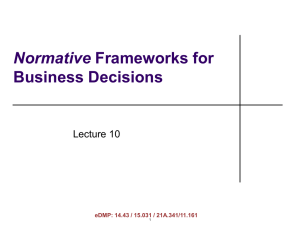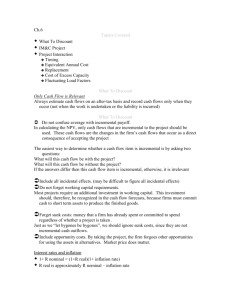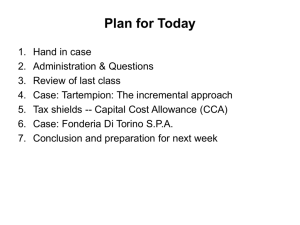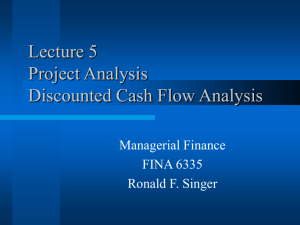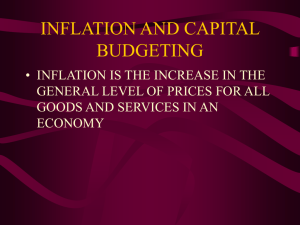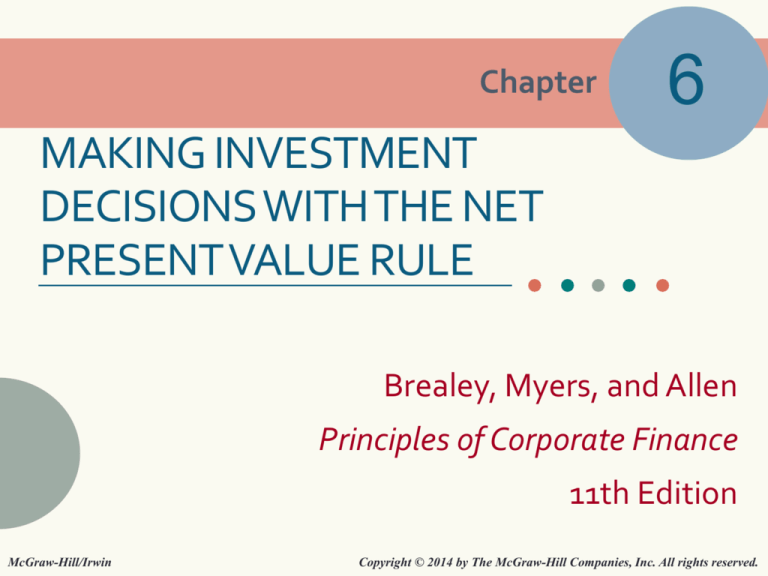
Chapter
6
MAKING INVESTMENT
DECISIONS WITH THE NET
PRESENT VALUE RULE
Brealey, Myers, and Allen
Principles of Corporate Finance
11th Edition
McGraw-Hill/Irwin
Copyright © 2014 by The McGraw-Hill Companies, Inc. All rights reserved.
6-1 APPLYING NET PRESENT VALUE RULE
• Rule 1: Only Cash Flow Is Relevant
• Capital Expenses
• Record capital expenditures when they occur
• To determine cash flow from income, add
back depreciation and subtract capital
expenditure
• Working Capital
• Difference between company’s short-term
assets and liabilities
6-2
6-1 APPLYING NET PRESENT VALUE RULE
• Rule 2: Estimate Cash Flows on an
Incremental Basis
• Include taxes, salvage value, incidental
effects, and opportunity costs
• Do not confuse average with incremental
payoffs
• Forecast sales today, recognize aftersales cash flow to come later
• Forget sunk costs
• Beware of allocated overhead costs
6-3
6-1 APPLYING NET PRESENT VALUE RULE
• Rule 3: Treat Inflation Consistently
• Use nominal interest rates to discount
nominal cash flows
• Use real interest rates to discount real
cash flows
• Same results from real and nominal
figures
6-4
6-1 APPLYING NET PRESENT VALUE RULE
• Inflation
• Example
• Project produces real cash flows of -$100 in year zero
and then $35, $50, and $30 in three following years.
Nominal discount rate is 15% and inflation rate is
10%. What is NPV?
Real discount rate =
1+ nominal discountrate
1+inflation rate
1
1.15
1 .045
1.10
6-5
6-1 APPLYING NET PRESENT VALUE RULE
• Inflation
• Example—Nominal figures
Year
Cash Flow
PV @ 15%
0
100
100
1
35 1.10 = 38.5
2
50 1.10 2 = 60.5
3
30 1.103 = 39.9
38.5
1.15
60.5
1.152
39.9
1.153
33.48
45.75
26.23
$5.5
6-6
6-1 APPLYING NET PRESENT VALUE RULE
• Inflation
• Example—Real figures
Year Cash Flow
0
100
1
35
2
50
3
30
PV@4.50%
100
35
1.045
50
1.0452
30
1.0453
= 33.49
= 45.79
= 26.29
= $5.50
6-7
6-1 APPLYING NET PRESENT VALUE RULE
• Separate Investment and Financing
Decisions
• Regardless of financing, treat cash outflows
required for project as coming from investors
• Regardless of financing, treat cash inflows as
going to investors
6-8
TABLE 6.1 IM&C’S FERTILIZER PROJECT, REVISED PROJECTIONS
($1,000S) REFLECTING INFLATION
6-9
6-2 IM&C’S FERTILIZER PROJECT
• NPV Using Nominal Cash Flows
1,630 2,381 6,205 10,685 10,136
NPV 12,000
2
3
4
1.20 1.20 1.20 1.20 1.205
6,110
3,444
3,520, or $3,520,000
6
7
1.20 1.20
6-10
TABLE 6.2 IM&C’S FERTILIZER PROJECT, CASH
FLOW ANALYSIS ($1,000S)
6-11
TABLE 6.3 IM&C’S FERTILIZER PROJECT, DETAILS OF CASH
FLOW FORECAST IN YEAR 3 ($1,000S)
6-12
TABLE 6.4 IM&C’S FERTILIZER PROJECT, TAX
DEPRECIATION
6-13
TABLE 6.5 IM&C’S FERTILIZER PROJECT, TAX
PAYMENTS ($1,000S)
6-14
TABLE 6.6 IM&C’S FERTILIZER PROJECT, REVISED
CASH FLOW ANALYSIS, ($1,000S)
6-15
6-3 USING THE NPV RULE TO CHOOSE PROJECTS
• Problem 1: Investment Timing Decision
• Some projects are more valuable if undertaken
in the future
• Examine start dates (t) for investment and
calculate net future value for each date
• Discount net values back to present
6-16
6-3 USING THE NPV RULE TO CHOOSE PROJECTS
• Problem 2: Choice between Long- and
Short-Term Equipment
• Example
• Given the following cash flows from operating two
machines and a 6% cost of capital, which machine
has the higher value using the equivalent annual
annuity method?
Year
Machine
0
1
2
3
PV@6%
E.A.A.
A
+15
+5
+5
+5
28.37
10.61
B
+10
+6
+6
21.00
11.45
6-17
6-3 USING THE NPV RULE TO CHOOSE PROJECTS
• Equivalent Annual Cash Flow, Inflation, and
Technological Change
• Inflation increases nominal costs of operating
equipment, but real costs remain unchanged
• Real cash flows are not always constant
6-18
6-3 USING THE NPV RULE TO CHOOSE PROJECTS
• Equivalent Annual Cash Flow and Taxes
• Lifetime costs should be calculated after tax
• Operating costs are tax-deductible
• Capital investment generates depreciation tax
shields
6-19
6-3 USING THE NPV RULE TO CHOOSE PROJECTS
• Problem 3: When to Replace an Old
Machine
• Example
• A machine is expected to produce a net inflow of
$4,000 this year and $4,000 next year before
breaking. You can replace it now with a machine that
costs $15,000 and will produce an inflow of $8,000
per year for three years. Should you replace now or
wait a year?
6-20
6-3 USING THE NPV RULE TO CHOOSE PROJECTS
• Problem 3: When to Replace an Old
Machine
• Example, continued
6-21
6-3 USING THE NPV RULE TO CHOOSE PROJECTS
• Problem 4: Cost of Excess Capacity
• Example
• A computer system costs $500,000 to buy and
operate at a discount rate of 6% and lasts five
years
• Equivalent annual cost of $118,700
• Undertaking project in year 4 has a present value of
118,700/(1.06)4, or about $94,000
6-22

